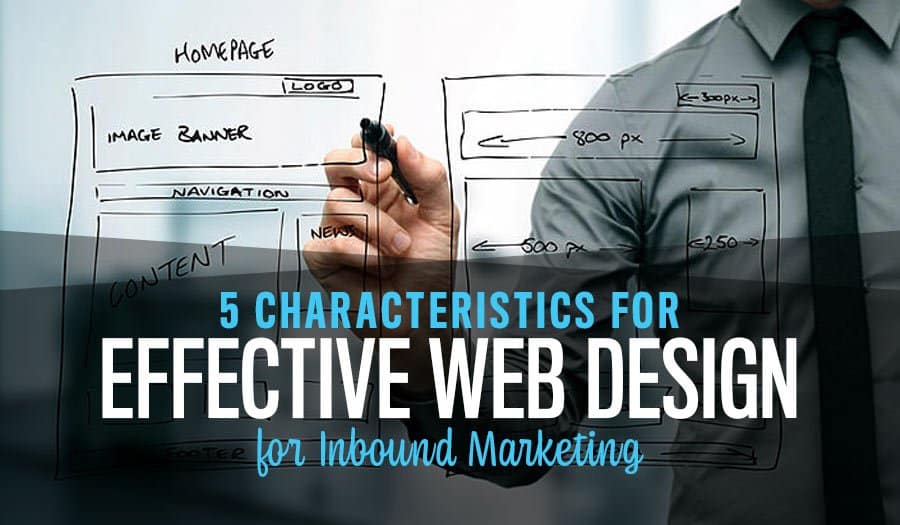What are some of the goals of inbound marketing? If you are a small business or startup, you likely want inbound marketing to increase brand awareness and attract more visitors to your website. Does that sound about right? Here are 5 Characteristics for Effective Web Design for Inbound Marketing.
5 Steps for Effective Web Design for Inbound Marketing
- Create Your Content Strategy & Plan Before the Design Begins
- Responsive Web Design Is Critical
- Prominently Feature Calls-to-Action
- Be Careful with Lead Capture
- Contact Information Must Be Easy to Find
You probably also expect that inbound marketing will increase your marketing-generated leads and conversion rates. Finally, there is also likely the expectation that inbound marketing will boost customer loyalty and retention. In any inbound marketing strategy, your website is the centrepiece. Consequently, your website design must provide an intuitive user experience that will work well within this marketing model.
The Goal of Inbound Marketing Website Design
One needs to start with an understanding of how inbound marketing is supposed to work. Essentially, a company generates unique, valuable, and free content distributed through various platforms. The target’s journey is described in terms of what marketers call a funnel. At the top of the funnel, the goal is to attract the target and capture their attention. Ideally, the best outcome is to make a potential customer part of your audience at the earliest stage of their decision-making process. For example, a person may start thinking about divorce a year before they are ready. However, while considering their actions, they are also doing research. A family law attorney will want to provide this potential client with the information they want and need, which then builds authority and trust. When the person is ready, that one family law attorney who they have been using as their primary resource becomes the obvious choice.
That said, inbound marketing is not just concerned with the person who is a year away from making a decision. The strategy creates content aimed to potential customers at every stage of the consumer life-cycle: target, prospect, lead, active customer, and past customer. This means producing content that will attract your target, building awareness about your company, products, and services. However, you also need content that will qualify and nurture leads. As visitors move through the funnel, content is optimized to generate requesting a salesperson get in touch or close a sale. Finally, there is content to retain customers and improve loyalty.
Regardless, just because you have content that will help people find your website does not mean they will like it once they are there. It is almost like creating a great product, but the packaging is horrible. Therefore, the only effective way to attract your target, build an audience, and convert leads is when inbound marketing and web design work together. Does that make sense to you?
Here is how you accomplish all that:
5 Steps for Effective Web Design for Inbound Marketing
1. Create Your Content Strategy & Plan Before the Design Begins
Far too often, content is the last consideration and it is reflected in the outcome. Your website design must provide an intuitive user experience. So, logic must be used for how the content is presented in relation to the overall design.
2. Responsive Web Design Is Critical
One fundamental characteristic of inbound marketing is allowing your target, leads, and customers to engage with you on their terms. Smartphones and mobile devices are the dominant way users consume content and are part of most people’s shopping process, even if they eventually buy in person.
3. Prominently Feature Calls-to-Action
CTAs are a vital element of inbound marketing web design. In fact, without landing pages and some kind of offer, there really is no way to guarantee that a visitor will ever return to your website to generate a sale eventually. Make sure that your calls-to-action stand out from the rest of the web page and use landing pages with special offers to entice visitors to complete sign-up forms.
4. Be Careful with Lead Capture
Repeated studies have shown that intrusive lead capture techniques, such as pop-ups create a negative impression on website visitors. So, using the right lead capture techniques is important. Consider something more along the line of a bar that appears above the navigation. Also, place lead capture forms in multiple places within the website.
5. Contact Information Must Be Easy to Find
Make sure your web designer is placing your company’s contact information wherever they can, not just on a “contact us” page. Inbound marketing is all about being useful and user experience. You don’t want people wasting their time hunting for your contact information. So, add contact information to the website header and footer.
Do you have any questions?
What haven’t we covered yet that is important to you? If you would like to talk more about our design characteristics for effective inbound marketing or a related topic, please contact us.
Let Sydney’s leading Web Design Agency take your business to the next level with a Pixel Fish Small Business Website.
Check out some of our latest Website Design projects and Testimonials.
Further Information:
Top 10 Tips to Create The Perfect Website Call to Action
Tips for Creating and Marketing a Financial Services Business Website
Top 10 Unbeatable WordPress Website UX Tips for your business
How to Drive Website Traffic with Podcasting for your business
Digital Branding: How to Create a Logo for your Digital Space
Top E-Commerce Shipping Options to Maximise Sales & Reduce Complexity
10 Social Media Publishing Tools To Streamline Your Content Marketing
The 8 Best Free Online Photoshop Alternatives
How to Create a Landing Page for Your Small Business: A Comprehensive Guide



